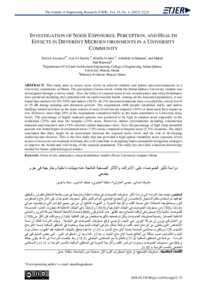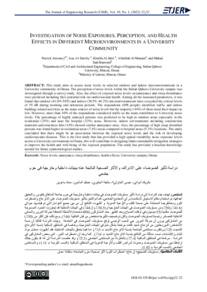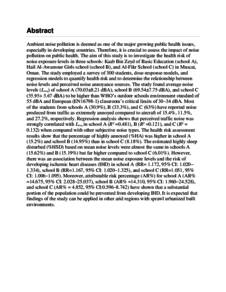Document
Investigation of noise exposures, perception, and health effects in different microenvironments in a university community.
Identifier
DOI: 10.53540/tjer.vol19iss1pp22-32
Source
Journal of Engineering Research. v. 19, 1 , p. 22-32
Contributors
Al-Harthy, Issa., Author
Al-Jabri, Khalifa., Author
Al-Mamun, Abdullah., Author
Baawain, Mahad Said., Author
Other titles
دراسة تأثیر الضوضاء على الادراك، والآثار الصحیة الناتجة عنھ ببیئات داخلیة وخارجیة في حرم جامعي
Country
Oman
City
Muscat
Publisher
Sultan Qaboos University.
Gregorian
2022-01-01
Language
English
English abstract
This study aims to assess noise levels in selected outdoor and indoor microenvironments in a University community in Oman. The perception of noise levels within the Sultan Qaboos University campus was investigated through a survey study. Also, the effect of exposed noise levels on annoyance and sleep disturbance were predicted including their potential risk on cardiovascular health. Among all the measured parameters, it was found that outdoor (41.6%-50%) and indoor (38.5%-46.2%) microenvironments have exceeded the critical levels of 55 dB during morning and afternoon periods. The respondents (698 people) identified traffic and indoor building-related activities as the main sources of noise levels but the majority (44%) of them rated their impact as low. However, more than 30% of the respondents considered traffic as the main contributor to University noise levels. The percentage of highly annoyed persons was predicted to be high in outdoor areas especially in the residential (25%) and near the hospital (13%) areas. However, indoor environments including construction materials and structures labs (14%) showed similar annoyance rates. Also, the percentage of high sleep disturbed persons was found higher in residential areas (7.4%) areas compared to hospital areas (5.3%) locations. The study concluded that there might be an association between the exposed noise levels and the risk of developing cardiovascular diseases. This is the first study that has provided a high spatial variability noise exposure levels across a University environment in Oman, this will contribute to designing future sustainable mitigation strategies to improve the health and well-being of the exposed population. The study has provided a baseline knowledge needed for future epidemiological studies.
ISSN
1726-6009
Category
Journal articles



